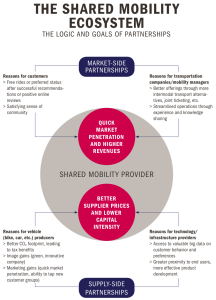The story of shared mobility in 2025
Origin of the story found on Roland Berger
In major cities across North America, Europe and Asia, shared mobility companies in 2025 handle around 10% of public passenger transportation, up from less than 1% in 2014. This huge leap forward is reflected primarily in large urban cityscapes, where distributed rental stations for e-cars and e-bikes have sprung up on every corner. This has proven to be the most convenient way to recharge batteries and provide customer service, and is now the established modus operandi for electric vehicles. The triumph of shared mobility has also given electromobility its long-awaited breakthrough. In big cities, e-cars are far more widespread than conventional autos: You sometimes consciously have to look out for the old gas guzzlers. Shared mobility networks boast a high vehicle density, and the next shared vehicle is on average never more than 200 meters away. That is one reason why many urban residents have given up owning their own car, with more people following their lead all the time. Even older people have caught the shared mobility bug. It has been a rerun of what happened with smartphones a good 15 years ago: Youngsters from the digital generation were the first to excitedly embrace the technology, and all the others followed gradually in their wake.
How to make a successful shared mobility company today: 10 Management principles
- First think big, then think profits
- Push supply to pull demand
- Build trust in your community
- Interact, integrate and connect with other mobility modes
- Study you customers, then study them some more
- Keep it simple and convenient
- Build your own ecosystem
- Lobby the authorities right from the start
- Think, act and recruit like a start-up
- Harness a jaw-dropping look and feel
But first of course you have to know how to acces the market. The fundamental question is wether you should launch your own company or acquire a company that already has some experience. And next to that: do you want to be an early mover or do you want to be smart and wait until the first wave of startups has washed over?
The three answers to the ‘what to be‘ question of Shared Mobility?
Ultimately resulting in the win-win situation of all parties in involved in The Shared Mobility Ecosystem






